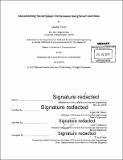| dc.contributor.advisor | Nigel H.M. Wilson and John P. Attanucci. | en_US |
| dc.contributor.author | Tarte, Lauren | en_US |
| dc.contributor.other | Massachusetts Institute of Technology. Department of Civil and Environmental Engineering. | en_US |
| dc.coverage.spatial | e-uk-en | en_US |
| dc.date.accessioned | 2015-10-30T18:56:51Z | |
| dc.date.available | 2015-10-30T18:56:51Z | |
| dc.date.copyright | 2015 | en_US |
| dc.date.issued | 2015 | en_US |
| dc.identifier.uri | http://hdl.handle.net/1721.1/99574 | |
| dc.description | Thesis: S.M. in Transportation, Massachusetts Institute of Technology, Department of Civil and Environmental Engineering, 2015. | en_US |
| dc.description | Cataloged from PDF version of thesis. | en_US |
| dc.description | Includes bibliographical references (pages 95-98). | en_US |
| dc.description.abstract | Although automated data collection systems have been in existence long enough to be the subject of extensive research, they continue to transform both the agency and customer side of public transportation. Transit system performance is defined along three dimensions: the supply of trains or buses; the demand from passengers; and the product of the two, service performance. This research takes a broad view of these dimensions, and explores several means of measuring each one, ways in which they interact, and how this information can be valuable for a transit agency. This thesis focuses specifically on the London Underground, but the intent is that the types of analysis described herein can be applied to any rail transit system with similar data resources. The research has three parts. First, a methodology is developed to estimate passenger volumes on the portion of a line between two adjacent stations within a defined time interval. This approach can be implemented using data from either smart card or entry and exit gates. It relies upon the outputs of London's Rolling Origin Destination Survey to infer passenger route choice. The second component identifies the possible causes of poor service performance in terms of both supply and demand, and defines a framework for examining supply and demand data to identify which causes are contributors. This research suggests that a better understanding of capacity constraints can be gained by jointly analyzing AVL-based capacity measures, AFC-based demand measures, and AFC journey times as a measure of service performance. Finally, this thesis explores the possibility of using smart card data in real time to estimate system state. This metric is defined as passenger accumulation, a measure of the number of passengers on a given portion of a line in real time. Building from the approach developed in the first section, this work designs a method to determine accumulation in real time at detailed levels of spatial granularity. The accumulation metric is then compared to Transport for London's existing tools to assess whether accumulation can provide value as a real-time indicator of system state. Based on this analysis and current data availability constraints it cannot be concluded that passenger accumulation provides a reliable indicator of real-time system state. | en_US |
| dc.description.statementofresponsibility | by Lauren Tarte. | en_US |
| dc.format.extent | 98 pages | en_US |
| dc.language.iso | eng | en_US |
| dc.publisher | Massachusetts Institute of Technology | en_US |
| dc.rights | M.I.T. theses are protected by copyright. They may be viewed from this source for any purpose, but reproduction or distribution in any format is prohibited without written permission. See provided URL for inquiries about permission. | en_US |
| dc.rights.uri | http://dspace.mit.edu/handle/1721.1/7582 | en_US |
| dc.subject | Civil and Environmental Engineering. | en_US |
| dc.title | Characterizing transit system performance using Smart Card data | en_US |
| dc.type | Thesis | en_US |
| dc.description.degree | S.M. in Transportation | en_US |
| dc.contributor.department | Massachusetts Institute of Technology. Department of Civil and Environmental Engineering | |
| dc.identifier.oclc | 924824707 | en_US |
